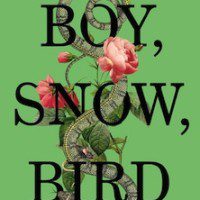Helen Oyeyemi’s luminous fifth novel Boy, Snow, Bird reimagines the Snow White fairytale as set in 1950s America. The novel opens, fittingly, with mirrors: “Nobody ever warned me about mirrors, so for many years I was fond of them, and believed them to be trustworthy.” The voice belongs to Boy Novak, the daughter of an abusive rat-catcher in Manhattan. She runs away to Flax Hill searching for beauty and escaping from an ugly past.
Flax Hill is a small town populated with what Boy calls “specialists,” including woodcutters and people who make bespoke cake toppers. The houses there are covered in brambles and everywhere Boy looks, there seems to be someone with an unsettling observation. For example, at one point, Boy is spending time with three dark-skinned teenagers who come to the bookstore where she works and read there. Boy notices Kazim, one of the teenagers, among a group trying to teach a parakeet the phrase Fuck Whitey. She notes Kazim’s presence to the girls and they express confusion; the person she thinks is Kazim is not Kazim. One of the girls says, “I guess we all look the same to you.” Seeing Boy’s confusion, another girl says, “It wasn’t him. Really. Kazim’s not a round-the-way boy. He stays home drawing and doing his wizard stuff. Relax. We all make mistakes.” Oyeyemi’s lack of explication after these startlingly blunt exchanges, gives the town and its inhabitants an uncanny feel; they are of our world and not of our world.
Nonetheless Boy feels that she fits into Flax Hill. “The town woke something like a genetic memory in me… after a couple of weeks, the air tasted right. To be more specific, the air took on a strong flavor of palinka, that fiery liquor I used to sneak capfuls of…” These lines could describe the effect of the novel, which works on readers’ memories by tapping into the unconscious, particularly the figures and tropes of children’s literature.
On a double date with another woman staying at her boarding house, Boy meets Arturo Whitman, a widowed jewelry maker with a teenaged daughter named Snow. Snow’s mother Julia died of complications from childbirth. Over a series of dates, Boy and Arturo don’t quite connect. He catches her staring at her own “mysterious smile” on the back of a dessert spoon and she doesn’t know how to reassure him that she’s not vain. But after a few deep conversations, he falls for her and introduces her to his daughter Snow.
Although our sympathies are with Boy at the outset, in her relationship with Snow she displays the dark turn of mind of an evil stepmother. Boy’s pursuit of beauty, which brought her to Flax Hill, proves to be an obsession. Boy hates how much Snow “tries,” saying that the reverence with which her in-laws look at Snow is too much: “Sure she was an extraordinary-looking kid. A medieval swan maiden… acting like that every time they laid eyes on her seemed to me like the fastest way to build an insufferable brat.”
Boy’s resentment hews to the Snow White fairytale even as it layers the story with fresh psychological insights. The book is not a simple retelling —it dips into wry meta-fiction. When Arturo proposes, he gives Boy a snake ring. Even the scales of the snake advance the mirror motif: “dozens of colorless hexagons that warped even as they reflected.” Boy shows her friend the ring, and her friend asks, “I mean, could that scream ‘wicked stepmother’ any louder?” When Boy’s old boyfriend Charlie comes to “rescue her” from her upcoming marriage, Boy rejects the offer. Later she tells the reader, “It’s better that Charlie and I didn’t make an automatic transaction, love exchanged for rescue. All you can do after that is put the love and the rescue upon the shelf…”
After Boy gives birth to her daughter, dark-skinned Bird Whitman, she discovers Arturo and his family are light-skinned African Americans who have been passing for white. The same women who love Snow’s beauty are barely able to look at Bird, noting only that she is healthy. According to Boy, “Snow’s beauty is all the more precious to Olivia and Agnes because it’s a trick. When whites look at her, they don’t get whatever fleeting, ugly impressions so many of us get when we see a colored girl.” Arturo’s mother suggests that Boy send Bird to live with her estranged, dark-skinned daughter. Instead Boy sends Snow away to live with her African American relatives.
The second section of the novel is told from Bird’s perspective, thirteen years after Boy sends Snow away. Like Boy, Bird is focused on perception and reflections, explaining, “Sometimes mirrors can’t find me. I’ll go into a room with a mirror in it and look around, and I’m not there. Not all of the time, not even most of the time, but often enough.” She theorizes as to why that might be the case: an optical illusion; that she’s not human; that this happens to everyone but they deny it.
Bird is fascinated by her absent half-sister. In the absence of empirical knowledge she makes up stories about Snow and writes her letters. The sisters’ correspondence is odd, oblique and filled with double meanings; they write as if they are mirrors of each other. Snow writes to Bird, “My reflection can’t be counted on, she’s not always there but I am, so maybe she’s not really me.” A more conventional novelist would allow Snow’s words to forge the bond between them, a simple cause and effect whereby two estranged sisters commiserate about an unusual experience and become intimate. But Bird upends expectations. She is angered by this attempt to relate; she accuses Snow of humoring her.
A preoccupation with storytelling, aesthetics and reflection shows up in strange, haunting digressions throughout the novel. We never know if a girl Bird sees in the forest is just a reflection of herself or a separate person. Doubles appear and disappear. Certain paths lead to dead ends. It’s to Oyeyemi’s credit that nothing in this novel feels planned or on-the-nose; every twist and turn feels organic, surprising and inevitable.
The novel’s fairytale elements tap into the reader’s subconscious while deconstructing America’s ideas about race. Oyeyemi can do this without alienating the reader because of the obvious delight that she takes in storytelling. As Oyeyemi portrays it, race in America is about perception. It’s about what we see and the stories we tell, rather than genetics or essential attributes.
In her first novel, Icarus Rising, and her more challenging but fascinating third novel, White is for Witching, Oyeyemi touched on racial tensions in Britain without sacrificing her marvelous ability to scare and delight. In both books she straddled Tzvetan Todorov’s distinction between the fantastic uncanny (supernatural elements that have a modern, rational explanation like mental illness) and the marvelous (supernatural elements that are as they seem to be), presenting the question Is this real? and offering a tentative response: it depends on the culture. Boy, Snow, Bird follows this pattern, but it deals less with the overtly marvelous, borrowing more from the fairytale’s imagery and symbolism than its fantastic particulars.
A mirror, as Boy defines it, presents “convincing and yet conflicting images of the same object, thereby leading onlookers astray.” Boy, Snow, Bird presents itself as a mirror of our real world, mixing fairytale and realist techniques, both convincing us and confounding our interpretive capacity. It is Oyeyemi’s most stunning novel to date, playfully confronting the racial politics that make Americans uncomfortable when addressed head-on. To mention “racial politics” in connection with a novel suggests something schematic, but Boy, Snow, Bird never preaches; it only reflects and refracts. Oyeyemi’s genius lies in her ability to show us our society and its fairytale double, both the truths we have always known and a fantastically weird dream we didn’t know we had been having.






One response
thank you for the review! great work.
to me one key element was the fact that Snow could only develop her racial identity while at her aunt’s, and a particular sense of self. the situation would be different if she was been allowed to stay at home. so, did Boy do her a favor? of course sending her away was mean and awful, but ended out in Snow being raised in an environment where she was not only valued to beauty/whiteness/looks.
i tried to explain it better here:
http://unbridledenthusiasm.net/2015/02/02/boy-snow-bird-by-helen-oyeyemi-2014/
Click here to subscribe today and leave your comment.